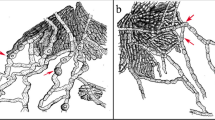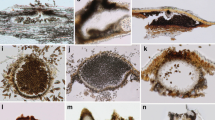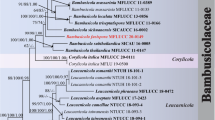Abstract
The molecular diversity of thirty-two different Morchella cultures/fruiting bodies, collected from the Western Himalayan region was studied in this investigation. Considerable taxonomic confusion exists regarding many species of Morchella. Although classical taxonomy is helpful in identification for many ascomycetes, morels exhibit considerable morphological diversity and there is disagreement in the identification of morel species. Phylogenetic analyses based on DNA sequences could help in sorting out morel taxonomy which is essential to better define the morel diversity. In this study, sequence analysis revealed that in the Western Himalayan region of India, both yellow (M. crassipes, M. spongiola) and black morels (M. elata, M. angusticeps, and M. gigas) were prominent along with two Verpa species. Phylogenetic analysis by maximum parsimony, maximum likelihood and Bayesian inference revealed two different clades and a clear distinction between yellow and black morels.



Similar content being viewed by others
References
Altschul SF, Gish W, Miller W, Myers FW, Lipman DJ (1990) Basic local alignment serach tool. J Mol Biol 215:403–410
Berthet P (1964) Essai biotaxonomique sur les discomyce`tes. PhD Thesis, Faculte′ des Sciences de l’Universite′ de Lyon, Lyon
Bunyard BA, Nicholson MS, Royse DJ (1994) A systematic assessment of Morchella using RFLP analysis of the 28S ribosomal RNA gene. Mycologia 86:762–772
Bunyard BA, Nicholson MS, Royse DJ (1995) Phylogenetic resolution of Morchella, Verpa and Disciotis [Pezizales: Morchellaceae] based on restriction enzyme analysis of the 28S ribosomal gene. Exp Mycol 19:223–233
Buscot FD, Wipf C, Battista DI, Munch JC, Botton B, Martin F (1996) DNA polymorphism in morels. I. PCR/RFLP analysis of the ribosomal DNA spacers and microsatellite primed PCR. Mycol Res 100:63–71
Diez J, Manjo JL, Martin F (2002) Molecular phylogeny of the mycorrhizal desert truffles (Terfezia and Tirmania), host specificity and edaphic tolerance. Mycologia 94:247–259
Hall TA (1999) BioEdit: a user-friendly biological sequence alignment editor and analysis program for Windows 95/98/NT. Nucl Acids Symp Ser 41:95–98
Jacquetant E (1984) Les morilles. Plantanida, Lausanne, Switzerland
Jandaik CL, Sharma SR (1995) Present status of Morchella in India. In: Chadha KL, Sharma SR (eds) Advances in Horticulture, pp 171–194
Katoh K, Toh H (2008) Recent developments in the MAFFT multiple sequence alignment program. Brief Bioinfo 9:286–298
Kellner H, Renker C, Buscot F (2005) Species diversity within the Morchella esculenta group (Ascomycota: Morchellaceae) in Germany and France. Org divers Evol 5:101–107
Kuo M (2009) Morchella tomentosa, a new species from Western North America, and notes on M. rufobrunnea. Mycotaxon 105:441–446
Lakhanpal TN, Shad OS (1986) Studies on wild edible mushrooms of Himachal Pradesh (N.W.Himalayas). II. Ecological relationships of Morchella species. Indian J of Mushrooms 12:15–20
Nilsson RH, Kristiansson E, Ryberg M, Larsson KH (2005) Approaching the taxonomic affiliation of unidentified sequences in public databases—an example from the mycorrhizal fungi. BMC Bioinfo 6:178
Nitha B, Meera CR, Janardhanan KK (2007) Anti-inflammatory and antitumour activities of cultured mycelium of morel mushroom, Morchella esculenta. Curr Sci 92:235–239
Pilz D, Weber N, Carter M, Parks C, Molina R (2004) Productivity and diversity of morel mushrooms in healthy, burned and insect-damaged forests of northeastern Oregon. For Ecol Manag 198:367–386
Ronquist F, Huelsenbeck JP (2003) MRBAYES3: bayesian phylogenetic inference under mixed models. Bioinfo 19:1572–1574
Royse DJ, May B (1990) Interspecific allozyme variation among Morchella spp. and its interferences for systematics within the genus. Biochem Syst Ecol 18:475–479
Ryber M, Nilsson RH, Kristiansson E, Topel M, Jacobsson S, Larsson E (2008) Mining metadata from unidentified ITS sequences in GenBank: a case study in Inocybe (Basidiomycota). BMC Evol Biol 8:50
Sohi HS, Kumar S, Seth PK (1965) Some interesting fleshy fungi from Himachal Pradesh. J Indian Bot Soc 54:69–73
Stamatakis A (2006a) Phylogenetic models of rate heterogeneity: a high performance computing perspective. In: Proceedings of IPDPS 2006. Rhodos, p 8
Stamatakis A (2006) RAxML-VI-HPC: maximum likelihood-based phylogenetic analyses with thousands of taxa and mixed models. Bioinfo 22:2688–2690
Stamatakis A, Hoover P, Rougemont J (2008) A rapid bootstrap algorithm for the RAxML Web Servers. Syst Biol 57:758–771
Stefani OPF, Sokolski S, wurtz T, Piche Y, Hamelin R, Fortin A, Berube JA (2010) Morchella tomentosa: a unique belowground structure and a new clade of morels. Mycologia 102:1082–1088
VanKan JAL, van den Ackerveken GFJM, de Wit PJGM (1991) Cloning and characterization of the cDNA of avirulence avr9 pathogen Cladosporium fulvum, the causative agent of tomato leaf mild. Mol Plant Microbe Interact 4:52–59
Waraitch KS (1976) The genus Morchella in India. Kavaka 4:69–76
Weber NS (1988) A morel hunters companion. Twopeninsula, Lansing
White TJ, Bruns T, Lee S, Taylor J (1990) Amplification and direct sequencing of fungal ribosomal RNA genes for phylogenetics. In: Innis MA, Gelfand DH, Sninsky JJ, White TJ (eds) PCR protocols: a guide to methods and applications. Academic, San Diego, pp 315–322
Wipf D, Fribourg A, Munch JC, Botton B, Buscot F (1999) Diversity of the internal transcribed spacer of rDNA in morels. Can J Micro 45:769–778
Wipf D, Munch JC, Botton B, Buscot F (1996) DNA polymorphism in morels: complete sequences of the internal transcribed spacer of genes coding for rRNA in Morchella esculenta (yellow morel) and Morchella conica (black morel). Appl Environ Microbiol 62:3541–3543
Yoon CS, Gessner RV, Romano MA (1990) Population genetics and systematics of the Morchella esculenta complex. Mycologia 82:227–235
Author information
Authors and Affiliations
Corresponding author
Rights and permissions
About this article
Cite this article
Kanwal, H.K., Acharya, K., Ramesh, G. et al. Molecular Characterization of Morchella Species from the Western Himalayan Region of India. Curr Microbiol 62, 1245–1252 (2011). https://doi.org/10.1007/s00284-010-9849-1
Received:
Accepted:
Published:
Issue Date:
DOI: https://doi.org/10.1007/s00284-010-9849-1




